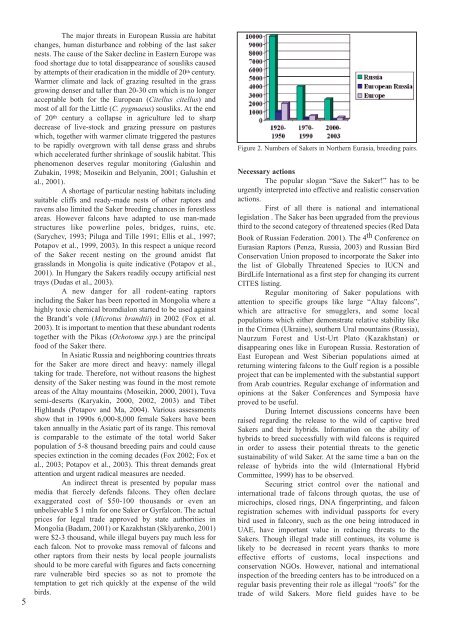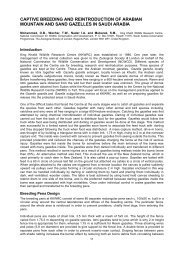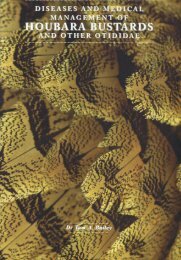His Highness Sheikh Zayed bin Sultan Al Nahyan - Wildlife Middle ...
His Highness Sheikh Zayed bin Sultan Al Nahyan - Wildlife Middle ...
His Highness Sheikh Zayed bin Sultan Al Nahyan - Wildlife Middle ...
Create successful ePaper yourself
Turn your PDF publications into a flip-book with our unique Google optimized e-Paper software.
5<br />
The major threats in European Russia are habitat<br />
changes, human disturbance and rob<strong>bin</strong>g of the last saker<br />
nests. The cause of the Saker decline in Eastern Europe was<br />
food shortage due to total disappearance of sousliks caused<br />
by attempts of their eradication in the middle of 20 th century.<br />
Warmer climate and lack of grazing resulted in the grass<br />
growing denser and taller than 20-30 cm which is no longer<br />
acceptable both for the European (Citellus citellus) and<br />
most of all for the Little (C. pygmaeus) sousliks. At the end<br />
of 20 th century a collapse in agriculture led to sharp<br />
decrease of live-stock and grazing pressure on pastures<br />
which, together with warmer climate triggered the pastures<br />
to be rapidly overgrown with tall dense grass and shrubs<br />
which accelerated further shrinkage of souslik habitat. This<br />
phenomenon deserves regular monitoring (Galushin and<br />
Zubakin, 1998; Moseikin and Belyanin, 2001; Galushin et<br />
al., 2001).<br />
A shortage of particular nesting habitats including<br />
suitable cliffs and ready-made nests of other raptors and<br />
ravens also limited the Saker breeding chances in forestless<br />
areas. However falcons have adapted to use man-made<br />
structures like powerline poles, bridges, ruins, etc.<br />
(Sarychev, 1993; Piluga and Tille 1991; Ellis et al., 1997;<br />
Potapov et al., 1999, 2003). In this respect a unique record<br />
of the Saker recent nesting on the ground amidst flat<br />
grasslands in Mongolia is quite indicative (Potapov et al.,<br />
2001). In Hungary the Sakers readily occupy artificial nest<br />
trays (Dudas et al., 2003).<br />
A new danger for all rodent-eating raptors<br />
including the Saker has been reported in Mongolia where a<br />
highly toxic chemical bromdialon started to be used against<br />
the Brandt’s vole (Microtus brandtii) in 2002 (Fox et al.<br />
2003). It is important to mention that these abundant rodents<br />
together with the Pikas (Ochotoma spp.) are the principal<br />
food of the Saker there.<br />
In Asiatic Russia and neighboring countries threats<br />
for the Saker are more direct and heavy: namely illegal<br />
taking for trade. Therefore, not without reasons the highest<br />
density of the Saker nesting was found in the most remote<br />
areas of the <strong>Al</strong>tay mountains (Moseikin, 2000, 2001), Tuva<br />
semi-deserts (Karyakin, 2000, 2002, 2003) and Tibet<br />
Highlands (Potapov and Ma, 2004). Various assessments<br />
show that in 1990s 6,000-8,000 female Sakers have been<br />
taken annually in the Asiatic part of its range. This removal<br />
is comparable to the estimate of the total world Saker<br />
population of 5-8 thousand breeding pairs and could cause<br />
species extinction in the coming decades (Fox 2002; Fox et<br />
al., 2003; Potapov et al., 2003). This threat demands great<br />
attention and urgent radical measures are needed.<br />
An indirect threat is presented by popular mass<br />
media that fiercely defends falcons. They often declare<br />
exaggerated cost of $50-100 thousands or even an<br />
unbelievable $ 1 mln for one Saker or Gyrfalcon. The actual<br />
prices for legal trade approved by state authorities in<br />
Mongolia (Badam, 2001) or Kazakhstan (Sklyarenko, 2001)<br />
were $2-3 thousand, while illegal buyers pay much less for<br />
each falcon. Not to provoke mass removal of falcons and<br />
other raptors from their nests by local people journalists<br />
should to be more careful with figures and facts concerning<br />
rare vulnerable bird species so as not to promote the<br />
temptation to get rich quickly at the expense of the wild<br />
birds.<br />
Figure 2. Numbers of Sakers in Northern Eurasia, breeding pairs.<br />
Necessary actions<br />
The popular slogan “Save the Saker!” has to be<br />
urgently interpreted into effective and realistic conservation<br />
actions.<br />
First of all there is national and international<br />
legislation . The Saker has been upgraded from the previous<br />
third to the second category of threatened species (Red Data<br />
Book of Russian Federation. 2001). The 4th Conference on<br />
Eurasian Raptors (Penza, Russia, 2003) and Russian Bird<br />
Conservation Union proposed to incorporate the Saker into<br />
the list of Globally Threatened Species to IUCN and<br />
BirdLife International as a first step for changing its current<br />
CITES listing.<br />
Regular monitoring of Saker populations with<br />
attention to specific groups like large “<strong>Al</strong>tay falcons”,<br />
which are attractive for smugglers, and some local<br />
populations which either demonstrate relative stability like<br />
in the Crimea (Ukraine), southern Ural mountains (Russia),<br />
Naurzum Forest and Ust-Urt Plato (Kazakhstan) or<br />
disappearing ones like in European Russia. Restoration of<br />
East European and West Siberian populations aimed at<br />
returning wintering falcons to the Gulf region is a possible<br />
project that can be implemented with the substantial support<br />
from Arab countries. Regular exchange of information and<br />
opinions at the Saker Conferences and Symposia have<br />
proved to be useful.<br />
During Internet discussions concerns have been<br />
raised regarding the release to the wild of captive bred<br />
Sakers and their hybrids. Information on the ability of<br />
hybrids to breed successfully with wild falcons is required<br />
in order to assess their potential threats to the genetic<br />
sustainability of wild Saker. At the same time a ban on the<br />
release of hybrids into the wild (International Hybrid<br />
Committee, 1999) has to be observed.<br />
Securing strict control over the national and<br />
international trade of falcons through quotas, the use of<br />
microchips, closed rings, DNA fingerprinting, and falcon<br />
registration schemes with individual passports for every<br />
bird used in falconry, such as the one being introduced in<br />
UAE, have important value in reducing threats to the<br />
Sakers. Though illegal trade still continues, its volume is<br />
likely to be decreased in recent years thanks to more<br />
effective efforts of customs, local inspections and<br />
conservation NGOs. However, national and international<br />
inspection of the breeding centers has to be introduced on a<br />
regular basis preventing their role as illegal “roofs” for the<br />
trade of wild Sakers. More field guides have to be




